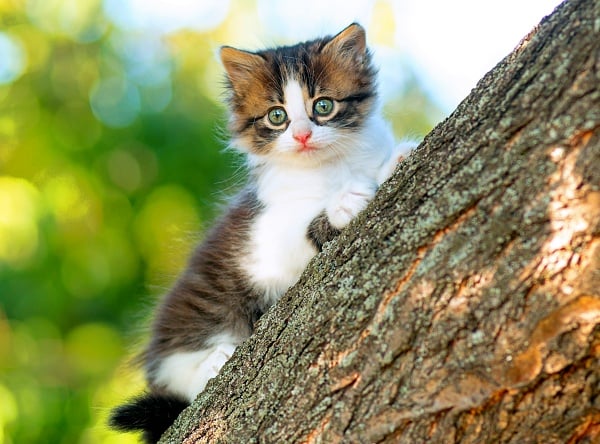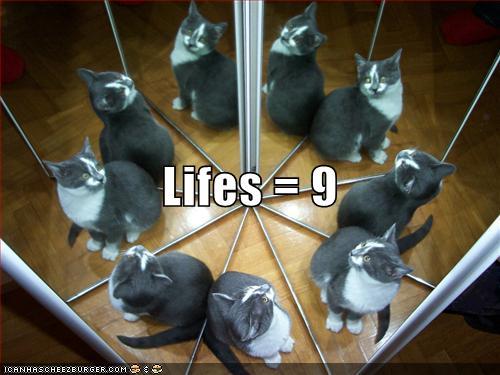Cats have nine lives right? Do they really? When you ask why cats have nine lives, it isn’t really a single question, but a series of them. What are the facts that might cause people to think cats have nine lives? Where did this legend come from? Why cats and not other animals? Why exactly nine lives?
In this article, you’ll learn how many lives cats have, where the myth came from, facts that support the myth, and why nine lives.

Table of Contents
Do cats have multiple lives?
Sadly no. Most people know that cats have only one life. When it is spent, sadly the cat is gone for good. While a hopeful idea, the nine lives myth is just that, a myth.

So why do people say that cats have nine lives. Did they really believe that our feline friends have nine lives or is it just an expression? We can’t know for sure. What is true is that cats have a knack for surviving dangerous situations using their great agility, survival skills, and something called the righting reflex. What’s funny is that despite these survival skills, our cats are scared of the vacuum cleaner. Something that can’t hurt them sends our cats running for cover. Same for yours?
Where did nine lives come from?
Well, it depends on whether people considered a cats’ sturdiness a good or bad thing. That brings us to Medieval and Early Modern Europe—a place where cats, mostly for religious reasons, were not treated well to say the least.
People burned cats at stakes, threw them off towers, and executed in several other ways during the witch hunts. This happened from the 15th to 19th centuries with a peak between 1580 and 1670.
This period strangely coincides with the repeated notions of cats having nine lives in English literature. Shakespeare’s Romeo and Juliet, Martson’s Dutch Courtesan, Butler’s Hudibras and other works from the 16th and 17th centuries mention cats having exactly nine lives.
The earliest written reference is Heywood’s Dictionary of Proverbs, which was published in 1561. It states that women have nine lives, just like cats. However, it implies that this was already an established expression: everyone knows that cats have nine lives. But hey, who knew that women have nine too?
Although this theory on the exact origin of this common myth is more plausible than others, it still leaves us clueless about why exactly nine.
Facts about cats having nine lives
The probable reason for this myth about cats having multiple lives likely stems from the sturdiness of cats. They are agile. They react quickly and have a good sense of balance, though their most notable skill is their uncanny ability to survive falls from surprising heights. That said, our cats are not immortal. Something like ingesting antifreeze from our car can kill them surprisingly quickly.
Cats like their ancestors millions of years ago, are tree dwelling animals that prefer high places for stalking their prey and avoiding larger animals. Such a lifestyle has significant evolutionary consequences, for example, creating animals that are good at surviving life threatening situations.
That is, cats who fell and died did not produce offspring; but offspring of those who fell without dying were likely to inherit characteristics that allowed them to survive:

- The Righting reflex of cats has been extensively studied and, with the invention of high-speed cameras, has been shown to be an almost artistic feat of acrobatics. Though we can’t say that cats ALWAYS land on their feet, they ALMOST always do. Not surprisingly, it helps them to survive when falling. This is one of their supernatural powers that may have led to the myth of cats having multiple lives.
- Surviving falls also helps them seem immortal. It wouldn’t be helpful if cats landed on their feet if their legs were stiff as concrete. But what if they had legs made of springs? Then they would take most of the impact away from the body and internal organs. Sorry no, cats don’t have springs in their legs, but they do have lightning fast reflexes to flex their joints (and to time it extremely well) is the next best thing.
- Relatively slow maximal falling velocity (known as “terminal velocity” in physics) also contributes to how cats survive falls. Quite often extremely high falls. When a cat reaches terminal velocity, it doesn’t really matter how long it takes to reach the ground. The basic physics of terminal velocity explain that large, but light objects (e.g. balloons) will fall slower than small, but heavy objects (e.g. bricks). In general, smaller mammals have slower terminal velocity, which is good for cats since they are relatively small. Of course, this relatively slow terminal velocity is useless by itself without righting reflex and quick reflexes to land softly. Having seen this on more than one occasion when our cats would do battle over the top perch on cat tree. Watching one cat fall off terrified us the first time it happened. But then we saw how gracefully they righted themselves mid fall, gently landing on all four paws and walking away like nothing happened.
There are enough reasons for cats to survive things that others animals wouldn’t. Thus it’s easy to imagine why earlier people believed the cat myth that they had multiple lives, even if they meant it figuratively. This goes further to explain why the myth of cats having multiple lives doesn’t extend to other animals like dogs for example. As we have many dogs and cats, it’s clear that our dogs wouldn’t survive in the wild where our cats would have no problem.
Why cats have nine, but not ten lives?

Putting physics and biology aside now, where does the saying originate? We’d love to ask historians, but there are currently too many claims about the origin of this phrase.
While researching this article, we discovered many false explanations that lead to only one reliable conclusion: no one really know why cats have exactly nine lives. Most of the commonly expressed theories simply have no factual basis.
The truth is that it wasn’t always nine. In some Spanish speaking countries and some German speaking cultures in Europe regarded it as seven. To add more controversy, Turkish and Arabic cultures say that cats have six lives. Thus, we can also ask why exactly six or seven lives? Can we know which phrase emerged first? Given the sturdiness of cats, these phrases could have been “invented” independently of each other, but we don’t know for sure.
For example, many sources tie the nine lives myth to a group of nine gods, often called the Trinity of Trinities, from Egyptian, Greek, and other mythologies, but there is no connection between these gods and cats. We have read the legends that the Egyptian cat goddess, Bastet, had nine lives. In fact, it was believed that all gods in Egypt were immortals which meant they had an infinite number of lives. Isn’t ancient Egyptian culture and mythology fascinating?
Nine was also a lucky number in ancient China culture where cats were treated well. But again, there’s no reason to justify why cats have nine lives. Maybe this why there were nine rings in Dante’s Hell, but who knows?
Besides, did the number have to be lucky at all? The interesting truth about numbers, especially single digit numbers, is that there aren’t many of them. Maybe the real reason why cats have exactly nine, seven, or six lives is because there weren’t many alternatives. It couldn’t be zero or one, yet two would seem too small.
Summary
As much as we all would love our feline family members to live forever, sadly there is no truth to the myth that cats have nine lives. Yes, they can survive situations that would kill or seriously injure other creatures. Like if you or I (heaven forbid) fell out of a tree, it would hurt, a lot. Our cats? Likely they’d simply land on their feet and walk away like nothing happened. For that, we can all be grateful.
You’ve learned how many lives cats have, where the myth came from, facts that support the myth, and why nine lives. While this won’t help your cat outlive you, it’s a good reminder that your four legged fur baby’s life is finite like ours. So please take care of your cat by keeping them at a healthy weight, and entertained. So make every moment a happy one with your pet cat. Because making your Pet Happy is what we all want.
FAQ
Question: Do cats really have nine lives?
Answer: No, cats have only one life.
Question: Where did the myth of cats having nine lives come from?
Answer: The myth likely originated from the sturdiness and survival skills of cats, which led people to believe they had multiple lives.
Question: Why not other animals? Why exactly nine lives?
Answer: The myth specifically relates to cats due to their agility, reflexes, and survival abilities. The exact number “nine” is unclear and might have different origins in various cultures.
Question: What facts support the myth of cats having multiple lives?
Answer: Cats’ righting reflex, quick reflexes, and relatively slow terminal velocity when falling contribute to their survival in life-threatening situations.
Question: What was the exact origin of the saying “cats have nine lives”?
Answer: The exact origin remains uncertain, and different cultures have associated cats with various numbers of lives, such as seven or six. The reasons for the specific numbers are not well-documented.
